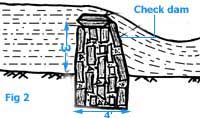
Vol. 2
No. 5
October 2000
|

Small efforts pay big dividends
G T Bhimte, a retired superintending engineer offers a simple low cost
solution to augment water availability: just stop the water when it flows. When he was in
service, he constructed small checkdams and this after his retirement, became his passion.
Bhimte has built small check dams in few areas of Madhya Pradesh and Maharashtra, which
have proved to be beneficial in making water available for irrigation and drinking
purposes. He believes that rainwater could be managed effectively by building small check
dams. Water, which normally use to flow waste during the monsoon is now being conserved
and eventually helping the people.
The most appealing aspect of Bhimte's indigenous methods is that the checkdams are not
only constructed at a cheaper rate but also by using locally available materials like
cement bags, boulders, coarse sand and black cotton soil . Bhimte has developed five
different indigenous methods of damming water in streams and rivulets. Following are the
description of all the five water harvesting structures developed by Bhimte.
  The first structure comprises of cement bags that
are stocked up to the height of 3 feet. The cement bags are filled with coarse sand and
mud and are properly stitched. The heap of bags is kept perpendicular to the direction of
the flow of the stream. Similar structures are placed in series for effective water
management. The first structure comprises of cement bags that
are stocked up to the height of 3 feet. The cement bags are filled with coarse sand and
mud and are properly stitched. The heap of bags is kept perpendicular to the direction of
the flow of the stream. Similar structures are placed in series for effective water
management.
  The second structure is more or less a permanent
one. The checkdam is constructed at a cheaper rate by making concrete mix using crushed
metal of different sizes and also various types of sand. Thus, the boulders are fixed with
RCC and on top of the structure cement bags filled with sand are put to retain more water
in the structure. The second structure is more or less a permanent
one. The checkdam is constructed at a cheaper rate by making concrete mix using crushed
metal of different sizes and also various types of sand. Thus, the boulders are fixed with
RCC and on top of the structure cement bags filled with sand are put to retain more water
in the structure.
 The third structure popularised by Bhimte has a height of approximately 3 feet. According
to Bhimte these structures can retain 10 to 20 per cent of water by planting grass in
between the stones that are placed in the structures. Bhimte has also brought about
certain innovation in this structure by putting cement bags in front of the structures.
The third structure popularised by Bhimte has a height of approximately 3 feet. According
to Bhimte these structures can retain 10 to 20 per cent of water by planting grass in
between the stones that are placed in the structures. Bhimte has also brought about
certain innovation in this structure by putting cement bags in front of the structures.
  Bhimte's
fifth structure is constructed along streams, by leaving a 'V' shaped opening in middle of
the permanent structure. The opening in the permanent structure is filled with cement
bags. The purpose of keeping the cement bags is to partially retain the water in the
structure. Bhimte's
fifth structure is constructed along streams, by leaving a 'V' shaped opening in middle of
the permanent structure. The opening in the permanent structure is filled with cement
bags. The purpose of keeping the cement bags is to partially retain the water in the
structure.
Bhimte believes that if people are sensitised regarding the benefits of water
harvesting then water crisis would be mitigated. Initially, he constructed small checkdams
in Chhindwara and Hoshangabad district of Madhya Pradesh. He also got an opportunity to
built Salaiyya check dam on Kaliyasote river near Bhopal. After the inspection of the
local administration Bhimte got sanction for four extra checkdams in 1994. The checkdams
of Hinotiya on Kaliyasot river, Inayatpur, Daulatpur on Kerwan river and Gol on Kerwan
tributary were constructed which solved the water problems near Bhopal.
He also assisted and supervised the construction of checkdams in Valani village of
Nagpur Maharashtra. Vidarbha Nature Conservation Society, a Nagpur-based NGO, was
implementing the project. After seeing the output the organisation in Nagpur has adopted
the programme in a big way.
Thus, the small but consistent efforts of Bhimte are paying good dividends in terms of
water availability with increased farm yield.
For further information
contact:
G T Bhimte
(Retired Superintending Engineer)
303 – D, Shalimar Township
Opposite Scheme No. 78,
Indore-452010
Ph. 0731-408 301 |